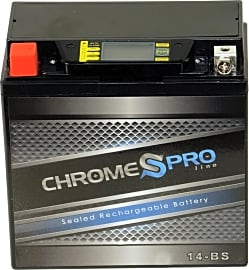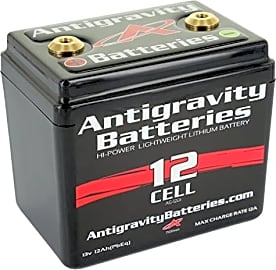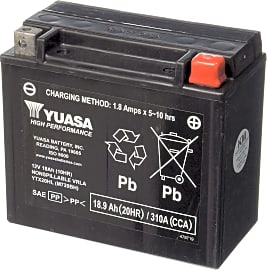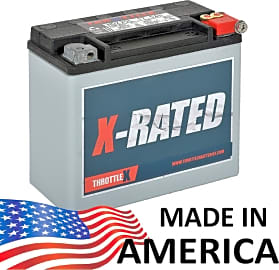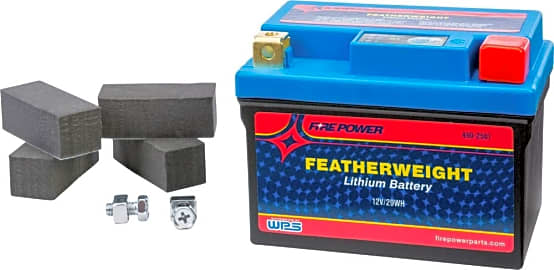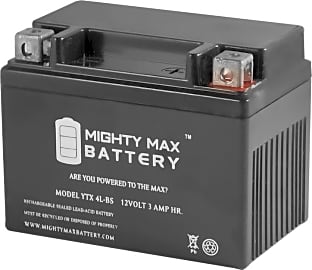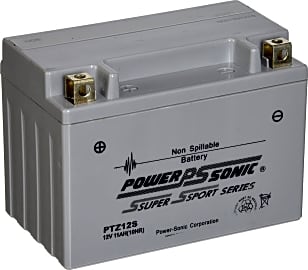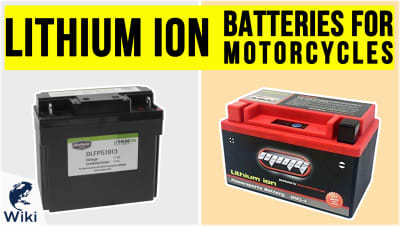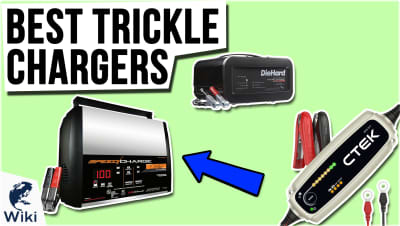The 10 Best Motorcycle Batteries

This wiki has been updated 41 times since it was first published in January of 2017. While many different factors can affect the life of a motorcycle battery, at some point over the course of your bike ownership, it is going to need replacing. Our selection features everything from basic, reliable lead-acid models to lightweight lithium-ion ones that boast low rates of self-discharge. They’re rated here based upon power, longevity, maintenance requirements, and price. When users buy our independently chosen editorial choices, we may earn commissions to help fund the Wiki.
Editor's Notes
December 04, 2020:
In order to better round out the list in this update, we added another lithium battery, the Antigravity AG-1201. The previous list only contained a couple of such models, which tend to weigh a lot less than traditional lead-acid ones, and also have a lower rate of self-discharge, making them a lot more efficient. This new addition weighs only 2-1/4 pounds, which makes it a good choice for high-performance sport bikes, since a lighter motorcycle handles better. Its impressive 360 cold cranking amps help ensure both reliable starting and a fast motor turnover. It features a small footprint and comes with installation foam that's handy if you're replacing a larger battery. To make room for this model, we removed the ACDelco ATX20LBS, which can suffer a relatively short lifespan. Some find the non-threaded terminals to be problematic during installation, and also many simply don’t feel the significant cost savings are warranted when you have to fill a battery with its acid and charge it once it arrives.
For a lithium-iron battery that features strong chemical and thermal stability, it’s hard to go wrong with the Shorai LFX14A4-BS12, which stays cool to the touch and boasts a long lifespan. It’s designed to weigh up to 80% less than typical lead-acid choices, and can start your vehicle quickly even in cold temperatures. Like the Antigravity model, this one comes with foam spacers, which prove useful when it’s being put in the place of a larger battery. If you’re looking for a sealed lead-acid model that requires little to no maintenance, check out the Chrome YTX14-BS iGel. Its absorbent glass mat technology keeps it from suffering leaks and corrosion. Unlike many, this one features a digital display that reads the battery’s alternator voltage and also warns you of a low voltage.
For safety’s sake you should wear protective glasses and gloves whenever installing, removing, or otherwise handling a motorcycle battery. Models that contain acid should be handled with care to avoid damaging clothing or injuring the skin. For more long-lasting, lightweight choices, see our list of lithium-ion batteries for motorcycles.
July 17, 2019:
Since our last update, relatively little has changed on the motorcycle battery marketplace, and we are pleased to see that our previous list stood the test of time. Most of our prior picks have held strong in the ranking, although we have bumped our previous top pick, the Chrome YTX14-BS iGel, to the #2 spot to make room for the Shorai LFX14A4-BS12. We liked that this one is a lithium-iron battery, which tends to be safer and more efficient than its lithium-ion counterpart. We also added the Yuasa YTX20HL to the bunch, placing it in the #3 spot, due its great value and impressive CCA rating of 310.
Getting To Know Your Battery
The sun is finally out and you're ready to take your shiny new sportster for a spin.
The sun is finally out and you're ready to take your shiny new sportster for a spin. You go down to the garage, pull it out into the driveway, and turn the key, expecting to hear that V-twin engine come alive in all its two-cylinder glory. Instead, what you get in response is a dreadful clicking sound — your battery is dead.
It's a common, not to mention headache-inducing, scenario, and one that any motorcycle enthusiast has likely dealt with at least once or twice over the course of his or her ownership. As two-wheeled technology has evolved to include larger engines and a whole host of other electronic components, batteries have become an integral part of the modern motorcycle, but they're still one of the most common parts to fail or fall into disrepair.
Motorcycle batteries today fall into one of a few broad categories, and it's important to consider the pros and cons of each before setting out to invest in a new one. Lead-acid batteries, including conventional wet cell and maintenance-free, are still the most common kind on the market, but they can differ significantly in terms of cost, quality, and convenience. The former are often more affordable than their competition, but are also prone to leaking and other drawbacks; the latter are lighter and more efficient, but are also usually more expensive. Lithium-ion batteries, which have gained in popularity as an aftermarket alternative to the lead-acid variety in recent years, are even more compact and energy-efficient, though those benefits are, again, usually negated by their higher cost.
Of course, type isn't the only aspect to take into account. Cold cranking amps are a measure of the battery's power at zero degrees Fahrenheit, while its amp-hour rating represents the battery’s ability to provide current for an extended period of time. If you frequently ride in the cold, a higher CCA will make your bike easier to start, whereas if you have a cruiser with a lot of electrical accessories, a higher amp-hour rating will help keep things running while at idle.
The Science Of Motorcycle Batteries
The means through which such an unassuming box produces enough energy to sustain your bike and all its gadgets may seem murky, but it's really just a matter of basic science. Simply put, a battery is device that can produce a direct current by converting chemical energy into electrical energy. The concept was first lit upon in the early 1800s, when John Frederic Daniell, a British chemist, created what is now known as the Daniell cell — an electrochemical cell consisting of a copper pot filled with a copper sulfate solution.
The means through which such an unassuming box produces enough energy to sustain your bike and all its gadgets may seem murky, but it's really just a matter of basic science.
Today's car and motorcycle batteries have evolved since those initial inventions, but they still make use of the same general processes. A modern battery will consist of one or more cells, with each cell containing of a number of plates, or electrodes, submerged in an electrolyte. When charging or discharging, ions, or atoms with a positive or negative charge, react with the electrolyte and the electrodes to create electrons, which transfer through an external circuit to create an electrical current.
In a lead-acid battery specifically, the electrode is a spongy lead plate, and the electrolyte a mixture of distilled water and sulfuric acid. As the battery discharges, these parts undergo chemical changes — the acid degrades into water, and the lead plates become coated with lead sulfate, which eventually causes the battery to go dead. The process can be reversed and the battery recharged by hooking the unit up to a higher voltage source, but overtime — three to four years according to most manufacturers — the battery will have to be replaced.
Maintenance-free batteries, including AGM and gel models, embody only a slightly different take to this system, since in the former the electrolyte is trapped in thin fiberglass sheets between the plates, and in the latter it comes in the form of a jelly-like substance. Lithium-ion batteries use altogether different materials, making them less prone to degradation.
How To Care For Your Battery
Despite the name, no battery is really completely maintenance-free — there are a few basic pointers for all types that should be followed to help ensure their proper functioning and to get the most of their life cycles. Keeping the terminals tight and clean to help create good contact is something you should do no matter what kind of battery you buy, as is making sure the case and its surrounding seat is clear of debris.
It's also important to avoid storing them in cold temperatures while they're in a discharged state, as that water is also liable to freeze and crack the casing.
Other tips may depend on what type of battery you have, as well as how often you ride. Conventional wet cell batteries must be topped off with water every now and again, since some of it will evaporate as a result of the chemical reaction taking place inside. It's also important to avoid storing them in cold temperatures while they're in a discharged state, as that water is also liable to freeze and crack the casing. AGM and gel batteries come in sealed cases that don't need refilling, resist freezing at low temperatures, and can hold their charge for longer periods — though that doesn't mean these should be left dead or discharged, either.
It's recommended that most batteries be hooked up to a trickle charger when not in use for more than a few weeks. These are specially designed devices that produce a very small current to keep your battery active over a long period, preventing it from self-discharging and running into the aforementioned problems. There is a wide range of affordable trickle chargers on the market today, including smart chargers that will quickly charge a fully depleted battery and then maintain it at a constant voltage.
Of course, the more you ride your bike, the more your battery will be kept active, and the healthier it will stay — at the end of the day, this might be the simplest way to care for your investment.


